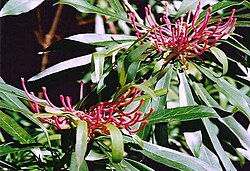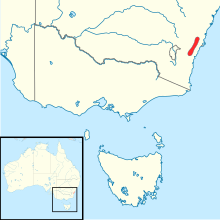Telopea mongaensis
| Telopea mongaensis | |
|---|---|
 |
|
| Telopea mongaensis at Monga National Park | |
| Scientific classification | |
| Kingdom: | Plantae |
| (unranked): | Angiosperms |
| (unranked): | Eudicots |
| Order: | Proteales |
| Family: | Proteaceae |
| Genus: | Telopea |
| Species: | T. mongaensis |
| Binomial name | |
|
Telopea mongaensis Cheel |
|
 |
|
| Distribution of Telopea mongaensis | |
Telopea mongaensis, commonly known as the Monga waratah or Braidwood waratah, is a shrub or small tree in the family Proteaceae. Endemic to Australia, it grows at high altitude in south eastern New South Wales, where it is often seen in moist areas at the edge of rainforest or by streams in eucalyptus forests. Growing to 6 m (20 ft) high, it has narrow green leaves 4–18 cm (1.6–7.1 in) in length, and 0.5–2 cm (0.20–0.79 in) wide. In spring bears many red flowerheads, each made up of 28 to 65 individual flowers.
In the garden, T. mongaensis grows in soils with good drainage and ample moisture in part-shaded or sunny positions. Several commercially available cultivars that are hybrid forms with T. speciosissima have been developed.
Telopea mongaensis grows as a tall shrub to 6 m (20 ft) high. The thin leaves are 4–18 cm (1.6–7.1 in) in length, and 0.5–2 cm (0.20–0.79 in) wide. The red flowers form in spring. Open, thin and wiry, the flowerheads (inflorescences) are not as spectacular as those of T. speciosissima but are much more numerous on the plant. Each flowerhead is around 6 to 10 cm (2.4 to 3.9 in) in diameter, and composed of anywhere from 28 to 65 individual small flowers, or florets. Each flower is encased in a perianth, which is a much brighter red on the surface facing the centre of the flower than the surface facing outwards. Anthesis, or the opening of the flowers, begins at the centre of the flowerhead and moves to the edges or base. The individual flower bears a sessile anther (that is, it lacks a filament), which lies next to the stigma at the end of the style. The ovary lies at the base of the style and atop a stalk known as the gynophore, and it is from here that the seed pods then develop. Meanwhile, a crescent shaped nectary lies at the base of the gynophore. The flowerheads are surrounded by green or pink leafy bracts 1.2–4.5 cm (0.47–1.77 in) in length, much less prominent than those of the New South Wales Waratah. Flowering is followed by the development of woody seed pods, 4.5–7 cm (1.8–2.8 in) long. The pods split longitudinally when mature and release the seeds.
It can be distinguished from the similar T. oreades, which generally has larger leaves and often grows with a tree-like habit. The leaves of the latter species tend to have less venation. Telopea oreades flowers around a month earlier than T. mongaensis in areas where they co-occur.
...
Wikipedia
